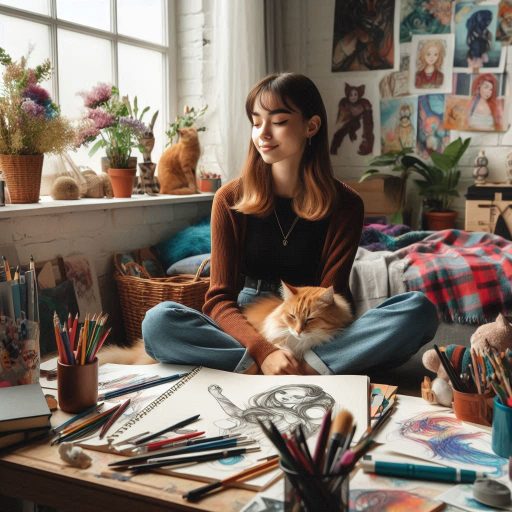Introduction
A strong concept art portfolio is crucial for any aspiring artist.
It serves as the first impression potential employers will have of your work.
In the competitive landscape of concept art, your portfolio can set you apart from others.
It showcases your skills, creativity, and unique artistic style, allowing you to present your best pieces to prospective clients or studios.
A well-organized portfolio highlights your ability to conceptualize ideas and execute them effectively.
It demonstrates your understanding of design principles, storytelling, and visual communication.
When tailored to your target audience, a strong portfolio can effectively capture the attention of hiring managers.
It can significantly enhance your chances of landing jobs in the industry.
Moreover, a strong portfolio reflects your growth as an artist.
It shows your dedication to refining your skills and exploring new techniques.
By continuously updating your portfolio, you can keep it fresh and relevant.
This commitment to improvement will resonate with employers seeking talented artists who are adaptable and eager to learn.
Determine your niche
Identify Your Area of Interest Within Concept Art (Characters, Environments, Props, etc
Building a strong concept art portfolio starts with determining your niche.
Your niche defines your area of interest within the concept art field.
This could include characters, environments, props, or other specialties.
Focusing on a specific niche helps you develop expertise and a unique style.
Begin by identifying what excites you most about concept art.
Reflect on the types of projects that inspire you.
Ask yourself which aspects of concept art you enjoy creating the most.
Do you love designing imaginative characters? Or do you prefer crafting detailed environments? Understanding your passion is essential for choosing a niche.
Next, evaluate your current skill set.
Assess your strengths and weaknesses in various areas of concept art.
If you excel in character design, focus on that aspect.
If environments spark your creativity, dedicate your efforts there.
Aligning your niche with your skills helps you create standout work.
It also boosts your confidence as you refine your abilities.
Choose a Niche That Aligns with Your Skillset and Passion to Stand Out in the Market
Consider the market demand for different niches.
Research current trends in the concept art industry.
Explore job postings and see which skills are most sought after.
A niche that aligns with your skills and market needs can enhance your job prospects.
However, don’t just choose a niche based solely on market demand.
Your passion for the subject should guide your decision as well.
After identifying your niche, focus on developing a cohesive body of work.
Your portfolio should showcase your unique style and expertise.
Create a series of related pieces that reflect your chosen niche.
For example, if you focus on character design, develop multiple characters with diverse personalities.
This approach demonstrates your versatility within your niche.
Incorporate your own voice and style into your portfolio.
Authenticity is vital for standing out in the competitive market.
Use your unique perspective to create work that reflects who you are as an artist.
Clients appreciate originality, and a distinctive style can set you apart.
As you build your portfolio, seek feedback from peers and mentors.
Constructive criticism can help you refine your work and identify areas for improvement.
Share your portfolio with others in the industry to gain insights.
Networking with other artists can provide valuable opportunities for growth.
Finally, keep your portfolio updated as you evolve as an artist.
As you gain new skills and experiences, replace older pieces with your best work.
Continuously refining your portfolio ensures it reflects your current abilities and style.
Determining your niche is crucial for building a strong concept art portfolio.
Identify your interests, align them with your skills, and focus on creating cohesive work.
With dedication and authenticity, you can develop a portfolio that stands out in the competitive concept art market.
Read: Collaborating with Other Creative Roles
Study industry trends
Research Current Trends in Concept Art to Understand What Is in Demand
To build a successful concept art portfolio, studying industry trends is essential.
Researching current trends allows you to understand what is in demand.
It helps you tailor your work to fit market expectations.
Start by exploring industry blogs, forums, and social media groups dedicated to concept art.
These platforms provide valuable insights into emerging styles and themes.
Attend art conventions and exhibitions to observe new ideas.
Networking with professionals at these events can offer firsthand knowledge.
You can also analyze popular video games, films, and animations to see what styles are trending.
Look for common elements that resonate with audiences and inspire creators.
This understanding helps you align your work with industry preferences.
Stay Updated on Popular Styles and Techniques Used by Professionals in the Field
Staying updated on popular styles and techniques is equally important.
The concept art field evolves rapidly, and new techniques frequently emerge.
Familiarize yourself with the software and tools industry professionals use.
Software like Adobe Photoshop, Procreate, and Blender are widely utilized.
Mastering these tools can enhance your efficiency and output quality.
Follow renowned concept artists on social media platforms.
Artists often share their creative processes and techniques, providing valuable learning opportunities.
Engage with their work by analyzing their styles and approaches.
Pay attention to how they tackle character design, environments, and prop creation.
Adopting techniques from successful artists can help you develop your style.
Additionally, watch online tutorials and take courses to learn new skills.
Platforms like YouTube, Skillshare, and Udemy offer tutorials on various aspects of concept art.
These resources can help you grasp advanced techniques and expand your skill set.
Embrace continuous learning to keep pace with industry developments.
Join online communities and forums focused on concept art.
Engaging with other artists fosters discussions about trends and styles.
You can gain insights into what works well and what doesn‘t.
Participate in challenges and contests to push your creative boundaries.
This involvement helps you practice your skills while staying updated on current trends.
Remember to balance your style with industry trends.
While it‘s important to be aware of popular techniques, maintain your unique voice.
Integrating your individuality into your work will help you stand out in a crowded market.
Aim to innovate and experiment while staying informed.
Studying industry trends is crucial for building a strong concept art portfolio.
Research current demands and stay updated on popular styles and techniques.
Read: Historic Costume Design Inspirations
Practice regularly
Dedicate Time Each Day to Practice and Improve Your Skills
Regular practice is essential for developing strong concept art skills.
Dedicate time each day to refine your techniques and expand your abilities.
Setting aside specific time for practice creates a routine that fosters improvement.
Even short daily sessions can yield significant results over time.
Aim for consistency rather than quantity; quality practice is more beneficial than long, sporadic sessions.
Establish achievable goals for each practice session.
Whether it‘s sketching characters, designing environments, or studying anatomy, having goals keeps you focused.
Track your progress to see how far you’ve come.
Celebrate small milestones to stay motivated.
This positive reinforcement encourages you to maintain your practice schedule.
Incorporate a variety of exercises into your practice.
Experiment with drawing from life, studying references, or recreating existing artwork.
Life drawing helps you understand anatomy and proportions better.
Studying references enhances your understanding of composition and color.
Recreating artwork allows you to analyze techniques and develop your unique style.
Experiment with Different Mediums and Styles to Enhance Your Versatility as an Artist
Experimenting with different mediums and styles is crucial for versatility.
Don‘t limit yourself to one type of art; explore various mediums like pencil, ink, digital, or paint.
Each medium offers unique challenges and learning opportunities.
For instance, digital art allows for easy corrections and experimentation.
Traditional mediums encourage a deeper understanding of color and texture.
Try out different styles to discover what resonates with you.
Create pieces in the styles of artists you admire.
This practice helps you analyze their techniques and incorporate them into your work.
As you experiment, you‘ll find elements that reflect your artistic voice.
Participating in art challenges can also enhance your skills.
Join online events or local groups that focus on specific themes or prompts.
These challenges push you to think creatively and explore new ideas.
They also provide a sense of community, allowing you to share your work and receive feedback.
Seeking constructive criticism is another effective practice strategy.
Share your work with peers, mentors, or online communities.
Feedback helps you identify strengths and areas for improvement.
Be open to criticism and use it as a tool for growth.
Consider creating a sketchbook dedicated to experimentation.
Fill it with studies, doodles, and quick sketches.
This space allows you to explore without pressure.
Documenting your journey also provides a valuable resource for future reference.
Regular practice is vital for enhancing your concept art skills.
Dedicate time each day to improve, and set achievable goals to stay motivated.
Experiment with different mediums and styles to expand your versatility as an artist.
Embrace challenges and seek feedback to foster continuous growth.
With dedication and creativity, you will elevate your concept art portfolio to new heights.
Read: Freelance vs. In-House Costume Design Jobs
Create original work
Focus on Developing Unique, Original Concepts That Showcase Your Creativity
Creating original work is essential for any aspiring concept artist.
Focus on developing unique concepts that reflect your creativity and individuality.
Start by brainstorming ideas that resonate with your interests.
Consider themes, characters, or environments that inspire you.
Allow your imagination to guide you in crafting something distinctive.
Engage in brainstorming sessions where you jot down any ideas that come to mind.
Don‘t censor your thoughts during this process; let your creativity flow.
Once you have a list, begin refining your concepts.
Choose the ideas that excite you most and explore them further.
Sketch rough drafts to visualize your thoughts and experiment with different compositions.
Challenge yourself to think outside the box.
Combine elements from various genres or themes to create something entirely new.
For instance, mix fantasy with science fiction to generate fresh concepts.
Such hybrid ideas can lead to innovative and engaging artwork that stands out in the industry.
Avoid Copying Existing Artwork and Instead Strive to Bring Something Fresh and Innovative to the Table
While it can be tempting to draw inspiration from established works, avoid copying existing artwork.
Imitating other artists may hinder your creative growth.
Instead, focus on finding your unique voice within the art community.
Use existing works as a reference point but allow your creativity to shine through.
When analyzing other artists‘ styles, ask yourself what elements you appreciate.
Is it their use of color, composition, or character design? Use this analysis to inform your work without imitating their pieces.
Strive to understand why certain works resonate with you, and channel that understanding into your creations.
Participate in idea generation exercises that encourage originality.
Set specific challenges for yourself, such as designing a character with unusual traits or creating an environment inspired by a specific emotion.
These exercises push your creative boundaries and help you develop a diverse portfolio.
Stay informed about trends in the concept art industry, but don‘t feel pressured to conform.
Instead of following trends, let them inspire your originality.
Use them as a backdrop to fuel your creative process.
By bringing a unique perspective to popular themes, you can create original works that captivate audiences.
Consider collaborating with other artists to foster originality.
Collaborative projects can introduce fresh ideas and perspectives.
Working with others can also challenge your usual creative process, leading to innovative outcomes.
Embrace these opportunities to learn and grow.
Creating original work is vital for your success as a concept artist.
Focus on developing unique concepts that showcase your creativity and individuality.
Avoid copying existing artwork and instead strive to bring fresh ideas to the table.
By embracing your originality, you can create compelling art that stands out in the competitive concept art landscape.
Seek feedback and critique
Share Your Work with Peers, Mentors, or Online Communities to Receive Constructive Feedback
Seeking feedback is crucial for your growth as a concept artist.
Share your work with peers, mentors, or online communities to gain insights.
Online platforms like art forums, social media groups, and portfolio sites are excellent for this purpose.
Engaging with others allows you to receive diverse perspectives on your artwork.
When sharing your work, be open to receiving critique.
Clearly state what type of feedback you seek.
Specify if you want opinions on composition, color choices, or overall concept.
This clarity helps others provide targeted feedback that aligns with your goals.
Participate in critique sessions or workshops when possible.
These environments foster constructive discussions around art.
You‘ll gain valuable insights and learn to articulate your thoughts on others‘ work.
This skill can improve your critical eye, making you a better artist.
Use Critique to Identify Areas for Improvement and Refine Your Portfolio
Critique offers a unique opportunity to identify areas for improvement.
Pay attention to the feedback you receive and take notes.
Look for common themes in critiques; if multiple people mention similar issues, consider addressing them.
This awareness allows you to refine your skills and enhance your portfolio.
It‘s essential to approach feedback with an open mind.
Constructive criticism is meant to help you grow, not discourage you.
Embrace the input as a tool for development rather than a personal attack.
Understand that every artist faces critiques and that it‘s part of the creative process.
After gathering feedback, take time to reflect on it.
Determine which suggestions resonate with you and your artistic vision.
Develop an action plan to incorporate these suggestions into your work.
This might involve revisiting specific pieces, experimenting with new techniques, or adjusting your overall style.
Regularly update your portfolio based on the feedback you receive.
As you improve and evolve as an artist, ensure your portfolio reflects your best work.
Remove pieces that no longer represent your skills or interests.
A polished portfolio showcases your growth and dedication to your craft.
Consider seeking mentorship from experienced artists.
A mentor can provide invaluable guidance and support.
Their insights can help you navigate challenges and enhance your skills.
Regular check-ins with your mentor can keep you accountable for your growth.
Seeking feedback and critique is vital for your development as a concept artist.
Share your work with peers, mentors, or online communities to receive constructive insights.
Use the feedback to identify areas for improvement and refine your portfolio.
Embrace critique as an essential part of your artistic journey, and continually strive for growth and excellence in your work.
Read: Networking Events for Costume Designers

Collaborate with others
Collaborate with Other Artists on Projects to Expand Your Skills and Network
Collaboration is a powerful tool for any aspiring concept artist.
Working with other artists allows you to expand your skills and network.
Collaborations can take many forms, such as joint projects, workshops, or group exhibitions.
Each opportunity helps you connect with like-minded individuals who share your passion for art.
Engaging in collaborative projects exposes you to different artistic styles and techniques.
You can learn from your peers while sharing your unique perspective.
This exchange of ideas fosters creativity and encourages growth.
Collaborating also helps you build valuable relationships within the art community.
Networking through collaborations can lead to future opportunities.
You might find potential clients, mentors, or collaborators for upcoming projects.
Such connections are vital in the competitive art industry, where relationships often lead to job offers or freelance work.
Working with Others Can Help You Gain New Perspectives and Enhance Your Portfolio with Diverse Experiences
Collaboration encourages you to think outside the box and embrace new perspectives.
When working with others, you‘ll encounter different approaches to problem-solving and creativity.
These experiences can challenge your artistic boundaries and inspire innovative ideas in your own work.
Additionally, collaborating on projects can lead to impressive additions to your portfolio.
You‘ll showcase not only your skills but also your ability to work within a team.
Diverse experiences in your portfolio demonstrate your adaptability and willingness to grow as an artist.
Engaging with a variety of artistic styles during collaborations can enhance your versatility.
You might experiment with different techniques, materials, or mediums that you wouldn‘t typically use.
This exploration allows you to broaden your artistic range and discover new interests.
Consider joining local art groups or online communities to find collaboration opportunities.
Participate in challenges, contests, or group projects that align with your interests.
Platforms like social media, art forums, and creative networks often host collaborative events where artists can join forces.
Furthermore, reach out to other artists whose work you admire.
Propose collaboration ideas that excite both parties.
A well-defined project can lead to fulfilling creative experiences and remarkable outcomes.
Be open to feedback and new ideas during the collaboration process.
Collaborating with others is essential for your growth as a concept artist.
Working with fellow artists helps expand your skills and network while gaining new perspectives.
Diverse experiences enhance your portfolio and showcase your adaptability.
Embrace collaboration as an opportunity to learn, grow, and create remarkable art together.
By fostering these connections, you‘ll strengthen your place in the art community and elevate your artistic journey.
Delve into the Subject: How to Choose the Right Web Design Course
Organize and showcase your work
Select Your Best Pieces and Organize Them in a Cohesive and Visually Appealing Manner
Organizing your artwork is essential for creating a strong portfolio.
Start by selecting your best pieces that truly represent your skills.
Aim for quality over quantity; it‘s better to showcase fewer exceptional works than many mediocre ones.
Review your collection and identify the pieces that highlight your unique style and strengths.
Once you have your top selections, arrange them in a cohesive manner.
Group similar works together based on themes, styles, or subjects.
This organization helps potential clients and employers navigate your portfolio easily.
A well-structured presentation showcases your attention to detail and professionalism.
Consider the flow of your portfolio.
Start with your strongest piece to grab attention.
Follow with a variety of works that demonstrate your versatility.
Conclude with another strong piece that leaves a lasting impression.
This strategy creates a narrative that guides viewers through your artistic journey.
Create an Online Portfolio or Website to Showcase Your Work to Potential Clients and Employers
In today‘s digital age, having an online presence is crucial for artists.
Create an online portfolio or website to showcase your work to potential clients and employers.
Choose a user-friendly platform that allows for easy navigation and visually appealing layouts.
Websites like Squarespace, Wix, or WordPress offer customizable templates tailored for artists.
Include high-quality images of your artwork, ensuring they accurately represent your skills.
Provide clear descriptions and context for each piece.
Share insights about your creative process, techniques, or the inspiration behind your work.
This information adds depth and engages viewers, making your portfolio more memorable.
Incorporate an ‘About‘ section to share your background and artistic journey.
Highlight your education, experiences, and influences that have shaped your art.
This personal touch helps clients connect with you on a deeper level.
Additionally, consider adding a blog or news section to your website.
Share updates on your projects, exhibitions, or collaborations.
Regularly updating your portfolio demonstrates your active engagement in the art community and keeps your work fresh in viewers’ minds.
Promote your online portfolio through social media and networking.
Share links to your work on platforms like Instagram, Twitter, or LinkedIn.
Engage with other artists and potential clients by participating in online art communities and discussions.
Building a strong online presence can lead to exciting opportunities in your career.
Organizing and showcasing your work is vital for establishing a successful concept art portfolio.
Select your best pieces and present them cohesively to make a strong impression.
Create an online portfolio or website to share your work with potential clients and employers.
By effectively organizing and promoting your art, you‘ll enhance your visibility and increase your chances of success in the industry.
Transform Your Career Today
Unlock a personalized career strategy that drives real results. Get tailored advice and a roadmap designed just for you.
Start NowKeep evolving and updating
Continuously Update Your Portfolio with New Work and Projects to Reflect Your Growth as an Artist
As an artist, your journey is one of continuous evolution.
Regularly updating your portfolio is essential to showcase your growth and development.
New projects, skills, and experiences should be reflected in your work.
By consistently adding fresh pieces, you demonstrate your commitment to improvement and adaptability.
Aim to update your portfolio at least once every few months.
This frequency allows you to incorporate recent works while also assessing your artistic progression.
New additions should highlight your latest techniques, styles, and ideas.
Remove older pieces that no longer represent your current skill level.
This helps maintain a high standard and ensures that your portfolio reflects your best work.
Make it a habit to document your creative process.
Capture sketches, concept art, or behind-the-scenes glimpses of your projects.
Sharing this evolution can provide potential clients with insight into your artistic journey and problem-solving abilities.
Stay Open to Feedback and Keep Pushing Yourself to Improve and Advance Your Skills
Embrace feedback as a valuable tool for growth.
Sharing your work with peers, mentors, or online communities can yield constructive critiques.
Use this feedback to identify areas for improvement and refine your artistic approach.
Being open to criticism helps you develop a more nuanced understanding of your work.
Pushing yourself to improve requires setting goals and seeking new challenges.
Experiment with different styles, mediums, or subjects that stretch your capabilities.
Take on projects outside your comfort zone to cultivate new skills.
Attend workshops, online courses, or art classes to expand your knowledge and expertise.
Engaging with the art community also exposes you to diverse perspectives and techniques.
Additionally, participate in art challenges or competitions.
These opportunities encourage you to produce work under specific themes or constraints.
They can inspire creativity and motivate you to create pieces that you might not have otherwise explored.
Networking with other artists can also provide inspiration and collaboration opportunities.
Surrounding yourself with like-minded individuals fosters a supportive environment where everyone can grow together.
Engage in discussions, share ideas, and learn from one another.
Evolving and updating your portfolio is crucial for staying relevant as a concept artist.
Regularly add new work to reflect your growth and ensure your portfolio remains current.
Stay open to feedback and continuously challenge yourself to improve your skills.
By embracing change and fostering a mindset of lifelong learning, you‘ll enhance your artistic journey and increase your success in the industry.
Conclusion
A strong concept art portfolio is vital for career advancement in the art industry.
It acts as your visual resume, showcasing your skills and creativity to potential employers.
A well-curated portfolio highlights your best work and demonstrates your ability to conceptualize and execute ideas effectively.
It can significantly impact job opportunities, freelance projects, and collaborations.
By following the outlined tips, you can create a portfolio that reflects your unique style and strengths.
Start by determining your niche and studying industry trends.
Practice regularly and focus on creating original work that showcases your creativity.
Seek feedback, collaborate with others, and organize your pieces in a visually appealing manner.
Lastly, continuously evolve your portfolio by updating it with new projects.
Now is the time to take action.
Begin building your concept art portfolio today.
Invest in your growth as an artist and remain open to new ideas and experiences.
Your portfolio will not only demonstrate your artistic journey but also open doors to exciting opportunities in the industry.
Your future as a successful concept artist starts now!




